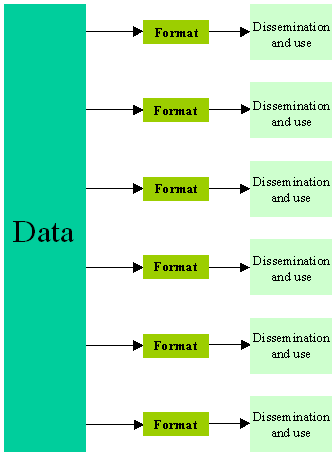Packaging Knowledge:
An Information Continuum
Hari Srinivas Policy Analysis Series E-080. June 2015.
The value of knowledge can be realized only when it is disseminated and shared - and used. The objective of this document is to list out the various formats in which knowledge can be packaged and discuss the circumstances under which these formats are used.
- Abstracts
- Acronyms
- Addresses
- Advertisements
- Advice
- Alerts
- Analysis
- Announcements
- Archives
- Artwork
- Atlas
- Audio
- Awards
- Best Practices
- Bibliographies
- Biographies
- Books
- Briefs
- Brochures
- Bulletins
- Calendar
- Cartoons
- Case Studies
- Catalogues
- Cause-and-effect
- CD-ROMs
- Charts
- Charts
- Checklists
- Chronicles
- Collections
- Columns
- Commentaries
- Comments
- Concepts
- Courses
- Data
- Databases
- Definitions
- Demonstrations
- Designs
- Diaries
- Dictionaries
- Directories
- Documents
- Drawings
- Editorial
- Encyclopaedia
- Essays
- Events
- Examples
- Excerpts
- Exercises
- Exhibitions
- Extracts
- Fact Sheets
- FAQs
- Feedback
- Films
- Fliers
- Flip-charts
- Forecasts
- Forums
- Frameworks
- Glossaries
- Good Practices
- Graphics
- Guidelines
- Guides
- Handouts
- Headlines
- Highlights
- Hypotheses
- Ideas
- Images
- Indicators
- Insights
- Introductions
- Issues
- Jokes
- Journals
- Keywords
- Lectures
- Letters
- Links
- Lists
- Manuals
- Maps
- Media Advisories
- Messages
- Methods
- Models
- Modules
- Namecards
- Newsletters
- Newspapers
- Notes
- Notices
- One-pagers
- Opinions
- Outlines
- Overviews
- Pamphlets
- Papers
- Patterns
- Periodicals
- Photographs
- Plans
- Posters
- Press Kits
- Profiles
- Prototypes
- Questions
- Recommendations
- References
- Reports
- Reviews
- Samples
- Scenarios
- Screenshots
- Series
- Showcases
- Sketches
- Slides
- Snapshots
- Software
- Solutions
- Speeches
- Spotlight
- Standards
- Statements
- Statistics
- Stories
- Strategies
- Suggestions
- Summaries
- Survey
- Systems
- Tables
- Talks
- Testimonials
- Themes
- Timelines
- Tools
- Topics
- Trends
- Tutorials
- Updates
- Videos
- Views
- Websites
- White papers
- Workbooks
- Working Papers
The collection listed below is broad. Some focus on the format of presentation, and some on the content of the message. Some use graphics to deliver the message, some use text. Some present the message in listed points or in summary/abstract format, some in descriptive/verbose format. Some formats are temporal, short-term or long-term, others atemporal. Some formats are specificaly developed for online dissemination environments, others offline - still others are appropriate for both environments.
The collection is therefore a continuum, an information continuum, where the position of an information format changes as the defining scales of the continuum itself change. The scales could be - size of the target audience, volume of info to be disseminated etc. Selecting an appropriate information packging format depends on a number of factors: (a) the problem or issue being addressed, (b) the decision-making process, (c) the information user/stakeholder - type as well as number of users, (d) the level/scale at which the activities are taking place, (e) the intended effect of providing the information, and (f) the medium through which the information is delivered.
Study the list carefully. Try to associate the format with the information in hand - and see how the message changes its 'digestability' depending on the format used. And answer the following questions: what is the message that is being delivered? What appripriate medium can be used for the purpose? Who are the target audience (including the type of audience, number and scale at which they function)? When, where and how is the actual dissemination to take place? The answer to these and related questions will help in selecting the appropriate format!
The same body of data can be used for different dissemination purposes, by modifiying the information format used.The list is in no way complete or exhaustive. The list was developed by scanning websites, library materials, newsletters and bulletins etc. Some may seem silly ('jokes'), or inappropriate ('spotlights' or talks'), or not quite an info format ('acronyms'), or simply the same ('snapshots' and 'photos'). But the objective behind this list is not to document or list all information formats, but to emphasize the need to think differently. Information dissemination is done not just through a 'book' or 'report' (yes, both are included in the list!) - but there are many, many other ways in which info can be presented, depending on the intended effect. Thus the same body of data or information can have totally different effects on its users, depending on the format used.

This approach is epitomised by the 'information pyramid'. Usually, only the top 'finished' information is visible or disseminated. Other interim formats, including the base - raw data - is simply not used and is lost except for the people actually generating the data. But these interim stages of information is equally important to create different types of useage and intended effects on the target audience.
This work by GDRC is licensed under a Creative Commons
Attribution-ShareAlike 4.0 International License. You are free to share and adapt this piece of work for your own purposes, as long as it is appropriately cited.
More info: http://creativecommons.org/licenses/by-sa/4.0/
on
Return to ICTs for Development
Contact: Hari Srinivas - hsrinivas@gdrc.org

